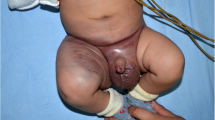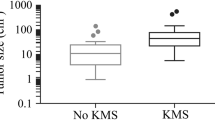Abstract
Tufted angiomas (TA) and kaposiform hemangioendothelioma (KHE) are classified as benign vascular tumors with locally aggressive potential. They share many similar histologic and clinical features and are believed to be two entities that lie along a spectrum (Le et al, Am J Surg Pathol 34:1563–1573, 2010; Osio et al, Arch Dermatol 146:758–763, 2010). Within the same tumor, there are focal areas of both KHE and TA histopathologic phenotype, and longitudinal transformation from TA to KHE has been described (Chu et al, Dermatology 206:334–337, 2003). A unique feature of these tumors is their potential to develop a severe, life-threatening coagulopathy called Kasabach-Merritt phenomenon (KMP) (Croteau SE and Gupta D, Semin Cutan Med Surg 35:147–52, 2016).
Access this chapter
Tax calculation will be finalised at checkout
Purchases are for personal use only
Similar content being viewed by others
References
Le Huu AR, Jokinen CH, Rubin BP, Mihm MC, Weiss SW, North PE, Dadras SS. Expression of prox1, lymphatic endothelial nuclear transcription factor, in Kaposiform hemangioendothelioma and tufted angioma. Am J Surg Pathol. 2010;34:1563–73.
Osio A, Fraitag S, Hadj-Rabia S, Bodemer C, de Prost Y, Hamel-Teillac D. Clinical spectrum of tufted angiomas in childhood: a report of 13 cases and a review of the literature. Arch Dermatol. 2010;146(7):758–63.
Chu CY, Hsiao CH, Chiu HC. Transformation between Kaposiform hemangioendothelioma and tufted angioma. Dermatology. 2003;206:334–7.
Jones EW, Orkin M. Tufted angioma (angioblastoma). A benign progressive angioma, not to be confused with Kaposi’s sarcoma or low-grade angiosarcoma. J Am Acad Dermatol. 1989;20(2 Pt 1):214–25.
Browning J, Frieden I, Baselga E, Wagner A, Metry D. Congenital, self regressing tufted angioma. Arch Dermatol. 2006;142:749–51.
Croteau SE, Liang MG, Kozakewich HP, Alomari AI, Fishman SJ, Mulliken JB, Trenor CC 3rd. Kaposiform hemangioendothelioma: atypical features and risks of Kasabach-Merritt phenomenon in 107 referrals. J Pediatr. 2013;162:142–7.
Gruman A, Liang MG, Mulliken JB, Fishman SJ, Burrows PE, Kozakewich HP, Blei F, Frieden IJ. Kaposiform hemangioendothelioma without Kasabach-Merritt phenomenon. J Am Acad Dermatol. 2005;52(4):616–22.
**Croteau SE, Gupta D. The clinical spectrum of kaposiform hemangioendothelioma and tufted angioma. Semin Cutan Med Surg. 2016;35:147–52.
***Drolet BA, Trenor CC 3rd, Brandao LR, Chiu YE, Chun RH, Dasgupta R, Garzon MC, Hammill AM, Johnson CM, Tlougan B, Blei F, David M, Elluru R, Frieden IJ, Friedlander SF, Iacobas I, Jensen JN, King DM, Lee MT, Nelson S, Patel M, Pope E, Powell J, Seefeldt M, Siegel DH, Kelly M, Adams DM. Consensus-derived practice standards plan for complicated Kaposiform hemangioendothelioma. J Pediatr. 2013;163:285–91.
Herron MD, et al. Tufted angiomas: variability of clinical morphology. Pediatr Dermatol. 2002;19:394–401.
Zukerberg LR, Nickoloff BJ, Weiss SW. Kaposiform hemangioendothelioma of infancy and childhood. An aggressive neoplasm associated with Kasabach-Merritt syndrome and lymphangiomatosis. Am J Surg Pathol. 1993;17(4):321–8.
Deraedt K, Vander Poorten V, Van Geet C, Renard M, De Wever I, Sciot R. Multifocal kaposiform haemangioendothelioma. Virchows Arch. 2006;448(6):843–6. Epub 2006 Apr 5.
Enjolras O, Mulliken JB, Wassef M, Frieden IJ, Rieu PN, Burrows PE, Salhi A, Léauté-Labreze C, Kozakewich HP. Residual lesions after Kasabach-Merritt phenomenon in 41 patients. J Am Acad Dermatol. 2000;42(2 Pt 1):225–35.
Hammill A, Mobberley-Schuman P, Adams D. Lymphoedema is a potential sequela of kaposiform hemangioendothelioma. Br J Dermatol. 2016;175(4):833–4.
Kelly M. Kasabach-Merritt phenomenon. Pediatr Clin N Am. 2010;57(5):1085–9.
Phillips WG, Marsden JR. Kasabach-Merritt syndrome exacerbated by platelet transfusion. J R Soc Med. 1993;86(4):231–2.
Szabo S, North PE. The histopathology and pathogenesis of vascular anomalies. In:Vascular tumors and developmental malformations: pathogenic mechanisms and molecular diagnosis. Molecular and translational medicine book series. New York: Humana Press (Springer); 2016. ISSN 2197-7860.
Lyons LL, North PE, Mac-Moune Lai F, Stoler MH, Folpe AL, Weiss SW. Kaposiform hemangioendothelioma: a study of 33 cases emphasizing its pathologic, immunophenotypic, and biologic uniqueness from juvenile hemangioma. Am J Surg Pathol. 2004;28:559–68.
North PE, Waner M, Buckmiller L, James CA, Mihm MC. Vascular tumors of infancy and childhood: beyond capillary hemangioma. Cardiovasc Pathol. 2006;15:303–17.
Arai E, Kuramochi A, Tsuchida T, Tsuneyoshi M, Kage M, Fukunaga M, Ito T, Tada T, Izumi M, Shimizu K, Hirose T, Shimizu M. Usefulness of D2-40 immunohistochemistry for differentiation between kaposiform hemangioendothelioma and tufted angioma. J Cutan Pathol. 2006;33:492–7.
North PE, Mizeracki A, Waner M, Mihm MC. GLUT1: a newly discovered marker for juvenile hemangiomas. Hum Pathol. 2000;31(1):11–22.
*Blei F, Karp N, Rofsky N, Rosen R, Greco MA. Successful multimodal therapy for kaposiform hemangioendothelioma complicated by Kasabach-Merritt phenomenon: case report and review of the literature. Pediatr Hematol Oncol. 1998;15:295–305.
**Drolet BA, Scott LA, Esterly NB, Gosain AK. Early surgical intervention in a patient with Kasabach-Merritt phenomenon. J Pediatr. 2001;138:756–8.
Yasui N, Koh K, et al. Kasabach-Merritt phenomenon: a report of 11 cases from a single institution. J Pediatr Hematol Oncol. 2013;35:554–8.
Haisley-Royster C, Enjolras O, Frieden IJ, Garzon M, Lee M, Oranje A, de Laat PC, Madern GC, Gonzalez F, Frangoul H, Le Moine P, Prose NS, Adams DM. Kasabach-merritt phenomenon: a retrospective study of treatment with vincristine. J Pediatr Hematol Oncol. 2002;24(6):459–62.
Wang Z, Li K, Yao W, et al. Steroid resistant Kaposiform Hemangioendothelioma: a retrospective study of 37 patients treated with vincristine and long-term follow up. Pediatr Blood Cancer. 2015;62:577–80.
***Tlougan BE, Lee MT, Drolet BA, Frieden IJ, Adams DM, Garzon MC. Medical management of tumors associated with Kasabach-Merritt phenomenon: an expert survey. J Pediatr Hematol Oncol. 2013;35(8):618–22.
Wang P, Zhou W, Tao L, Zhao N, Chen XW. Clinical analysis of Kasabach-Merritt syndrome in 17 neonates. BMC Pediatr. 2014;14:146. https://doi.org/10.1186/1471-2431-14-146.
Fernandez-Pineda I, Lopez-Gutierrez JC, Ramirez G, Marquez C. Vincristine-ticlopidine-aspirin: an effective therapy in children with Kasabach-Merritt phenomenon associated with vascular tumors. Pediatr Hematol Oncol. 2010;27:641–5.
Schaefer BA, Wang D, Merrow AC, Dickie BH, Adams DM. Long-term outcome for kaposiform hemangioendothelioma: a report of two cases. Pediatr Blood Cancer. 2017;64(2):284–6. https://doi.org/10.1002/pbc.26224. Epub 2016 Oct 4.
Hammill AM, Wentzel M, Gupta A, Nelson S, Lucky A, Elluru R, Dasgupta R, Azizkhan RG, Adams DM. Sirolimus for the treatment of complicated vascular anomalies in children. Pediatr Blood Cancer. 2011;57:1018–24.
**Adams DM, Trenor CC 3rd, Hammill AM, Vinks AA, Patel MN, Chaudry G, Wentzel MS, Mobberley-Schuman PS, Campbell LM, Brookbank C, Gupta A, Chute C, Eile J, McKenna J, Merrow AC, Fei L, Hornung L, Seid M, Dasgupta AR, Dickie BH, Elluru RG, Lucky AW, Weiss B, Azizkhan RG. Efficacy and safety of sirolimus in the treatment of complicated vascular anomalies. Pediatrics. 2016;137:1–10.
Matsumoto H, Ozeki M, Hori T, Kanda K, Kawamoto N, Nagano A, Azuma E, Miyazaki T, Fukao T. Successful Everolimus Treatment of Kaposiform Hemangioendothelioma With Kasabach-Merritt Phenomenon: clinical efficacy and adverse effects of mTOR inhibitor therapy. J Pediatr Hematol Oncol. 2016;38(8):e322–5.
Oza VS, Mamlouk MD, Hess CP, Mathes EF, Frieden IJ. Role of Sirolimus in advanced Kaposiform Hemangioendothelioma. Pediatr Dermatol. 2016;33(2):e88–92. https://doi.org/10.1111/pde.12787. Epub 2016 Feb 11.
Uno T, Ito S, Nakazawa A, Miyazaki O, Mori T, Terashima K. Successful treatment of Kaposiform hemangioendothelioma with everolimus. Pediatr Blood Cancer. 2015;62(3):536–8. https://doi.org/10.1002/pbc.25241. Epub 2014 Oct 12.
Mizuno T, Emoto C, Fukuda T, Mobberley-Schuman P, Hammel A, Adams D, Vinks A. Developmental pharmacokinetics of sirolimus; implications for dosing in neonates and infants with vascular anomalies. ISVAA abstract 106. 2016.
Shimano K, LongBoyle J, Mathes E, Meyer A, Rosbe K, Dowd C, Cooke D, Frieden I. Neonates require lower sirolimus doses to achieve therapeutic levels for treatment of vascular anomalies. ISVAA abstract 361. 2016.
Chiu YE, Drolet BA, Blei F, Carcao M, Fangusaro J, Kelly ME, Krol A, Lofgren S, Mancini AJ, Metry DW, Recht M, Silverman RA, Tom WL, Pope E. Variable response to propranolol treatment of kaposiform hemangioendothelioma, tufted angioma, and Kasabach-Merritt phenomenon. Pediatr Blood Cancer. 2012;59:934–8.
Barlow CF, Priebe CJ, Mulliken JB, Barnes PD, Mac Donald D, Folkman J, Ezekowitz RA. Spastic diplegia as a complication of interferon Alfa-2a treatment of hemangiomas of infancy. J Pediatr. 1998;132:527–30.
Wu HW, Wang X, Zhang L, et al. Interferon-alpha therapy for refractory kaposiform hemangioendothelioma: a single center experience. Sci Rep. 2016;6:36261.
Leaute-labreze C, et al. Tufted angioma associated with platelet trapping syndrome: response to aspirin. Arch Dermatol. 1997;133:1077–9.
DeKlotz CM, Langevin KK, Dohil M. On response of tufted angiomas to low-dose aspirin. Pediatr Dermatol. 2014;31:123–4.
**Javvaji S, Frieden IJ. Response of tufted angiomas to low-dose aspirin. Pediatr Dermatol. 2013;30:124–7.
Hanna BD, Bernstein M. Tranexamic acid in the treatment of Kasabach-Merritt phenomenon. Am J Pediatr Hematol Oncol. 1989;11(2):191–5.
To assist the reader in gaining familiarity with available evidence, the following rating system has been used to indicate key references for each chapter’s content:
***: Critical material. Anyone dealing with this condition should be familiar with this reference.
**: Useful material. Important information that is valuable in in clinical or scientific practice related to this condition.
*: Optional material. For readers with a strong interest in the chapter content or a desire to study it in greater depth.
Author information
Authors and Affiliations
Corresponding author
Editor information
Editors and Affiliations
Rights and permissions
Copyright information
© 2018 Springer International Publishing AG, part of Springer Nature
About this chapter
Cite this chapter
Gupta, D., Geddis, A., Chun, R. (2018). Tufted Angioma and Kaposiform Hemangioendothelioma. In: Perkins, J., Balakrishnan, K. (eds) Evidence-Based Management of Head and Neck Vascular Anomalies. Springer, Cham. https://doi.org/10.1007/978-3-319-92306-2_9
Download citation
DOI: https://doi.org/10.1007/978-3-319-92306-2_9
Published:
Publisher Name: Springer, Cham
Print ISBN: 978-3-319-92305-5
Online ISBN: 978-3-319-92306-2
eBook Packages: MedicineMedicine (R0)




